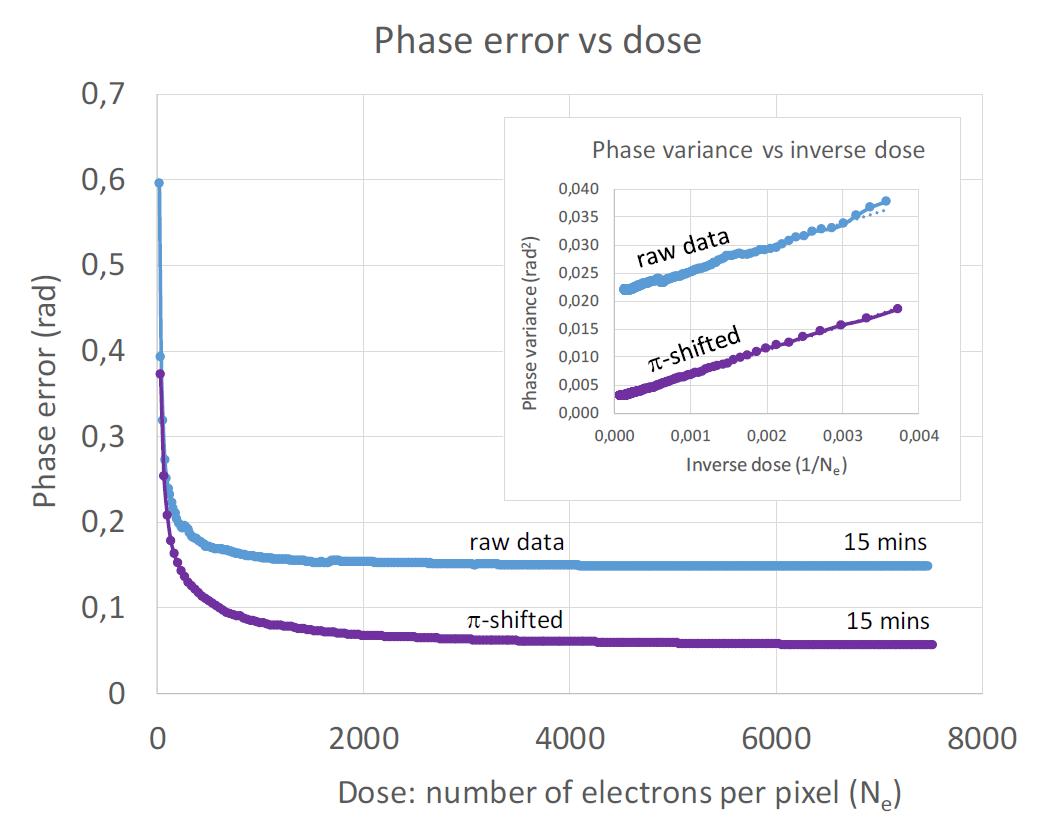Revisiting phase detection limits in electron holography through dynamic automation
- Abstract number
- 439
- Event
- European Microscopy Congress 2020
- DOI
- 10.22443/rms.emc2020.439
- Corresponding Email
- [email protected]
- Session
- PST.1 - Phase Microscopy
- Authors
- Dr Martin Hytch (1), Mr Julien Dupuy (1, 3), Dr Vadim Migunov (2), Dr Thibaud Denneulin (2), Dr Rafal Dunin-Borkowski (2), Dr Christophe Gatel (1, 3)
- Affiliations
-
1. CEMES-CNRS
2. Ernst Ruska Centre
3. Université de Toulouse
- Keywords
Automation, Electron holography, Direct electron detectors
- Abstract text
The precision with which electron holography can be used to measure local field strengths – electric, magnetic or elastic strain – is directly related to the precision with which the phase of the holographic fringes can be determined. Random errors are related to fringe visibility and the electron dose [1] but also depend on the transfer characteristics of the detector [2] and the mask used in the Fourier reconstruction [3]. For a hologram of visibility V0 before detection, the expression for the standard deviation of the phase on a pixelated detector can be written [4]:
where N0 is the number of electrons per pixel, DQE(q) the quantum efficiency of the detector at the spatial frequency corresponding to the hologram fringes and “a” a factor depending on the Fourier mask size. This expression does not take into account the systematic errors, from for example Fresnel fringes in single-biprism mode or the distortions of the fibre optics of the detector [3].
Apart from optimising the fringe visibility and a change of detector, random errors can therefore be reduced by increasing the electron dose. Acquiring holograms over longer exposure times, however, is compromised by instrumental instabilities that reduce the visibility of the hologram fringes over time [5]. This has led to the development of acquiring hologram series in the form of image stacks [6]. Here, we reinvestigate the validity of the expression for the dose-related phase detection limits in controlled conditions by compensating microscope instabilities through dynamic automation and feedback control [7].
Identical experiments were performed on two different microscopes: the I2TEM (Hitachi HF3300-C) microscope in Toulouse and the Titan-Holo (ThermoFisher) in Juelich. Holograms that covered the field of view were acquired at comparable dose rate (< 9 e-/pixel/s) and fringe spacing (5.5 pixels), the main difference being that a high-speed conventional CMOS camera (OneView, Gatan Inc.) was used on the I2TEM and a direct electron detector (K2, Gatan Inc.) operating in counting mode on the Titan-Holo. Hologram phases were monitored in real-time [8] and dynamic automation was implemented on both microscopes through customised scripts written for DigitalMicrograph (Gatan Inc.) [7]. Holograms were acquired over 15 minutes (900 s) for two different values of the phase, 1 rad and 1-pi rad, to allow for pi-shifted reconstruction of the phase by subtracting the two hologram series [9,10]. In order to analyse the phase error as a function of dose, holograms were also recorded every 4 s during acquisition.
Phase images were calculated using a hard square mask centred on the side band of lateral size of 0.18 pixel-1. The standard deviation of the phase was measured in a small area to avoid the effect of long-range distortions for the 1 rad hologram series and plotted as a function of dose (see Figure 1). Even for very high dose, there appears to be a constant, dose-independent, phase error. To see this in more detail, we can plot the variance of the phase against the inverse dose (see inset, Figure 1) where an intercept is clearly visible. For the I2TEM this corresponds to 145 mrad. However, for the pi-shifted holograms the dose-independent phase error is three times smaller at 51 mrad.
Results for the Titan-holo with the K2 camera will be presented in comparison to these initial results, along with the analysis to determine the origin of the constant phase error.
Figure 1: Phase detection limits for double-biprism holograms on the I2TEM microscope (Hitachi HF3300-C) operating at 300 kV and recorded on a OneView camera (Gatan). Dose rate of 8.7 e-per pixel per second over a total acquisition time of 15 minutes. Standard deviation of the phase of the raw holograms (blue curve) and pi-shifted holograms (purple curve). Inset, same data plotted as variance against inverse dose. Intercept gives dose-independent phase detection limit.
The research leading to these results has received funding from the European Union Horizon 2020 research and innovation programme under grant agreement No. 823717 – ESTEEM3.
- References
[1] A Harscher and H Lichte, Ultramicroscopy 64 (1996), p. 57.
[2] WJ de Ruijter and JK Weiss, Ultramicroscopy 50 (1993), p. 269.
[3] E Voelkl and D Tang, Ultramicroscopy 110 (2010), p. 447.
[4] SLY Chang, C Dwyer, J Barthel, CB Boothroyd and RE Dunin-Borkowski, Ultramicroscopy 161 (2016), p. 90.
[5] SLY Chang, C Dwyer, CB Boothroyd and RE Dunin-Borkowski, Ultramicroscopy 151 (2014), p. 37.
[6] RA McLeod, M Bergen and M Malac, Ultramicroscopy 141 (2014), p. 38.
[7] C Gatel, J Dupuy, F Houdellier and MJ Hÿtch, Appl. Phys. Lett. 113 (2018), p. 133102.
[8] HoloLive! v1.1 (HREM Research Inc.) a plug-in for DigitalMicrograph (Gatan Inc.) for real-time phase images during electron holography experiments. www.hremresearch.com
[9] VV Volkov, MG Han and Y Zhu, Ultramicroscopy 134 (2013), p. 175.
[10] V Boureau, R McLeod, B Mayall and D Cooper, Ultramicroscopy 193, p. 52 (2018).


